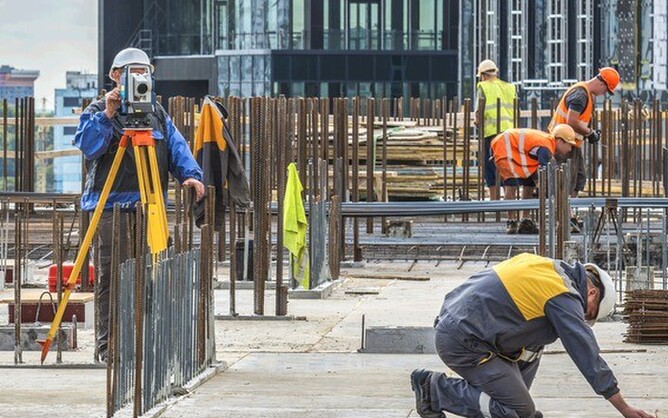Lean construction is a methodology rooted in maximizing value for customers while minimizing waste. Borrowed from the manufacturing sector, the principles of lean construction are designed to make the construction process more efficient, predictable, and productive.
At PE Builders, we believe that integrating lean construction principles into residential and commercial construction services in NYC is key to delivering efficient, high-quality results. By following lean principles, we make sure that every project we undertake, whether it is a residential complex or a healthcare facility, is executed with precision and value.
Respect for People
At the heart of lean construction is the principle of respect for people. This principle emphasizes the importance of trust, communication, and collaboration among all stakeholders involved in a project. By fostering an environment of mutual respect, everyone from the owners to the workers feels empowered to contribute meaningfully.
In lean construction, teams work together more effectively when all members are valued for their input and expertise. A collaborative atmosphere reduces conflict and leads to more innovation and problem-solving on site. This respect extends to subcontractors, partners, and even clients, encouraging an integrated approach where all parties share the responsibility of achieving project success.
Eliminate Waste
Waste elimination is one of the cornerstones of lean construction. Waste comes in many forms on a construction site: materials, time, excess labor, and inefficiencies in workflow. Lean construction targets eight types of waste:
Defects: Any work that has to be redone due to mistakes.
Overproduction: Completing tasks ahead of schedule or producing more than needed.
Waiting: Idle workers or equipment waiting on materials or other tasks to be completed.
Non-utilized Talent: Failing to leverage workers' full skills and expertise.
Transport: Unnecessary movement of materials and equipment.
Inventory: Stockpiling more materials than necessary.
Motion: Inefficient movements by workers due to poor site layout.
Over-processing: Adding unnecessary steps to a process that do not add value.
Eliminating these wastes minimizes unnecessary costs and makes sure that resources are used efficiently. For example, by avoiding overproduction or overstocking materials, builders can reduce excess inventory and cut costs.
Focus on Process Flow
In lean construction, maintaining a steady flow of work is essential to preventing delays and disruptions. The goal is to make sure that each task flows smoothly from one to the next without bottlenecks. Achieving this requires detailed planning, constant communication, and coordination between different teams on the site.
Effective flow management relies on synchronizing schedules so that every team member knows exactly when their task begins and ends. It is particularly important in large projects like healthcare buildings in NYC, where multiple contractors and suppliers need to work together seamlessly.
Flow interruptions, such as waiting for materials or delays in one phase holding up another, can significantly impact the project timeline. Focusing on process flow helps lean construction minimize these interruptions, guaranteeing that projects stay on track.
Generate Value for the Customer
A critical principle of lean construction is the focus on value generation for the customer. Value is defined by the customer’s needs, expectations, and goals for the project. This principle requires builders to have a clear understanding of what the client deems valuable—whether it is reducing project costs, delivering a sustainable building, or meeting a specific completion deadline.
To generate value, it is necessary to align the project’s design, construction, and outcomes with the customer's vision. Lean construction encourages the involvement of all stakeholders early in the project so that each phase adds value and is not just completed for the sake of progress. By focusing on the customer’s value expectations, construction teams can reduce unnecessary tasks that do not contribute to the overall project goals.
Continuous Improvement (Kaizen)
In lean construction, continuous improvement, often referred to as Kaizen, is the philosophy of ongoing incremental changes that contribute to project success. The goal is to consistently evaluate processes and seek out opportunities to improve efficiency, quality, and safety throughout the construction process. It emphasizes learning from mistakes and applying lessons to future projects.
Key aspects of Kaizen include:
Feedback Loops: Construction teams regularly assess their work and solicit feedback to identify bottlenecks and inefficiencies.
PDCA Cycle: Following the Plan-Do-Check-Act (PDCA) approach allows for structured problem-solving and continuous refinement.
Employee Involvement: Workers at all levels are encouraged to suggest improvements, creating a culture of innovation and engagement.
By embedding the practice of continuous improvement, lean construction projects become progressively more efficient over time, reducing waste, enhancing quality, and making sure that every team member contributes to better overall project performance.
Optimize the Whole
While many traditional construction methods focus on optimizing individual tasks or components of a project, lean construction emphasizes optimizing the entire process. The holistic view encourages teams to consider how every action impacts the project as a whole.
For instance, focusing solely on getting a task done quickly might result in delays down the line if it was not done correctly or if it interferes with another team’s progress. Lean construction avoids these pitfalls by considering how each step in the process fits into the bigger picture.
Collaboration is essential for this principle. When different teams, from architects to general contractors in NYC, work together, they can optimize their efforts for the overall success of the project, rather than just completing individual tasks.
Pull Planning and Scheduling
Pull planning is a key element in lean construction that prioritizes tasks based on demand from downstream operations. Instead of scheduling work based on a master plan, lean construction teams release tasks as needed to avoid bottlenecks and delays.
The pull planning process helps:
Reduce overproduction and waiting by aligning task completion with real-time demand.
Increase communication between contractors and subcontractors, guaranteeing that everyone is synchronized with the project schedule.
Minimize the risk of one team getting too far ahead or behind, which can create inefficiencies and delays in workflow.
By focusing on pulling work based on actual needs, the principle improves flexibility, helping to meet deadlines and keep the construction process more predictable and manageable.
Decentralized Decision-Making
Decentralized decision-making empowers workers on the ground to make quick decisions without always waiting for approvals from higher management. This principle is crucial in lean construction, where reducing bottlenecks and maintaining workflow efficiency is key.
The benefits of decentralized decision-making include:
Faster resolutions to issues that arise on-site, as team members who are directly involved in the process have the authority to address problems in real-time.
Reduced downtime, as decisions are made closer to the point of action, cutting out unnecessary delays.
Increased worker ownership of tasks, which improves engagement and accountability.
The principle fosters a collaborative environment where decisions can be made at various levels, creating a more responsive and agile team structure that can adapt to changing circumstances on-site.
Building Information Modeling (BIM)
Building Information Modeling (BIM) enhances collaboration and coordination among all stakeholders in a construction project by creating a shared digital model. BIM allows for the visualization and simulation of different elements of the project, which can help identify potential conflicts early on and streamline construction workflows.
Advantages of BIM include:
Enhanced coordination between architects, engineers, and construction teams through a shared 3D model that everyone can access and update.
Early identification of design clashes or structural issues, which helps reduce costly rework later in the process.
Better resource planning and allocation, as teams can simulate different scenarios and plan for the most efficient use of materials, labor, and time.
BIM is a valuable tool in lean construction as it promotes collaboration, enhances decision-making, and reduces waste by identifying inefficiencies early in the design and construction phases.
Reduce Variability
Variability in construction processes can lead to inefficiencies, delays, and additional costs. The principle of reducing variability aims to create more predictable and reliable workflows by standardizing processes where possible and minimizing disruptions.
Key aspects of reducing variability include:
Standardizing tasks to make sure that they are executed the same way every time. This leads to more consistent outcomes and reduces the risk of errors.
Improving supply chain coordination to help materials be delivered on time and in the right quantities, minimizing disruptions caused by shortages or excess inventory.
Reducing workflow interruptions by addressing potential bottlenecks and guaranteeing that each team has what they need to complete their tasks without unnecessary waiting times.
Reducing variability in construction helps maintain a smooth workflow, so all teams can work efficiently without unnecessary delays, ultimately helping the project stay on schedule and within budget.
At PE Builders, we integrate lean principles into every project we take on, guaranteeing that each step of the process is efficient and value-driven. Whether we're providing pre-construction services or managing complex healthcare or commercial developments, lean construction methods are at the core of our approach.
By prioritizing these techniques, we reduce waste, streamline workflows, and optimize resources, ultimately delivering projects on time and within budget. The benefits extend beyond just cost savings for our clients; lean construction enhances collaboration, minimizes delays, and makes the entire building process smoother, leading to high-quality results and greater overall project success.

